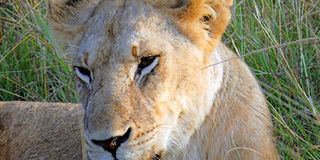OUT&ABOUT: On a mission to count lions

A lion at Nairobi National Park. PHOTO| RUPI MANGAT
What you need to know:
- Sunrise on Nairobi’s open spaces is ethereal.
- We missed the sunrise by a few minutes because it takes so long to get through the line at the Kenya Wildlife Service pay-station.
The Nairobi sky was red-hot before sunrise as we made our way to the gates of Nairobi National Park.
And l have to say this again with pride — it’s the only national park in a city centre that teems with wildlife such as the big cats — lions, leopards and most recently, a cheetah that was spotted after decades.
The natural wilderness park was established in 1946.
Feeling a little self-important because not everyone goes counting lions so near home — literally from my door to the gate minus traffic took 20 minutes- we the members of Friends of Nairobi National Park (FoNNaP) listened in rapt attention to the Lion Guardian research scientists giving instructions on how to go about logging in lions spotted by each team, with great prizes to be won for most lions sighted and most distance covered.
And the hunt began.
Sunrise on Nairobi’s open spaces is ethereal. We missed the sunrise by a few minutes because it takes so long to get through the line at the Kenya Wildlife Service pay-station.
But picture this — a rising mist over the great expanse and sky turning blue over the gold-coloured plains of the park.
With the lion ID sheet and camera ready to shoot, a thought crossed my mind. Each lion had to be photographed face-on, left face, and right face in clear pictures.
This is because lion whisker spots are like human fingerprints. They never change and you can identify an individual lion from the spots. But would the lion oblige?
Then we came across Nairobians like Patricia Heather-Hayes, who has been visiting the park every Sunday since she was a teenager.
She’s on first name basis with the lions. There are several people including youngsters, who are so addicted to the lions that you can see them in the park most weekends — and have created a Facebook page for FoNNaP, where they upload fantastic sightings.
In the early morning, the buffaloes herd was still limbering up having their morning drink at the stream. The ostriches strode the plains with the gazelles and giraffes.
At the dam near the Athi-Kitengela, a crocodile lay on the banks. We also spotted hippos, the critically endangered listed Grey crowned cranes and other water birds.
But there’s no lion in sight — despite having driven to the very extreme of the eastern side past Mokoyeti Gorge. We return our blank lion ID sheets. Another group returned two days later with pictures of Amani, Leboya, Alamayia; Morana; Sidai plus 14 more that included three cubs.
“Nairobi National Park is a small area and well-studied by citizen scientists like FoNNaP,” explained Dr Salisha Chandra of Lion Guardians, a conservation organisation dedicated to finding and enacting long term solutions for people and lions to coexist across Africa. So far, they have worked in Amboseli.
LION MOVEMENTS
They are trying out a software called LINC, Lion Identification Network of Collaborators (in this case FoNNaP). It’s a facial recognition software. Fourteen of the 19 lions seen over the weekend of 19-20 January 2019 have individual lion profiles (ID cards) on LINC.
“We’re looking at lion movements in a broad landscape,” says Chandra. “Lions move out of protected areas and we want to know where they disperse and which corridors they are using to inform conservation.”
Nairobi National Park has challenges because it’s increasingly becoming surrounded by buildings, and now with the eyesore that is the standard gauge railway cutting right through it despite the fact that national parks are gazetted.
It goes against the epic words of the founding father of Kenya, Mzee Jomo Kenyatta in 1963 — “The natural resources of this country — it’s wildlife, which offers such an attraction to visitors from all over the world, the beautiful places in which these animals live, the mighty forests which guard the water catchment areas so vital for the survival of man and beast — are a priceless heritage for the future. The government, fully realising the value of its natural resources, pledges itself to conserve them for posterity with all means at its disposal.”
The following weekend, we’re back in the park for another FoNNaP activity — to pull out the super-invasive parthenium weed that’s spreading like wildfire across Africa. The tiny wicked weed is lethal. A plant matures in a month and bursts up to 50,000 seeds — and then renders the soil infertile while no wildlife or domestic animal eats it. We spot a lioness in the morning mist and follow her crossing the plains.
To add to the excitement, a gigantic white rhino and her calf cross the road and by lunch time, a guest from India, a senior citizen — is overwhelmed because he has never seen animals in the wild.
We settle for a sumptuous barbecue at the Kenya Wildlife Service club house.
Join In
FoNNaP — https://fonnap.org/ — is a great
group of people. Join them and enjoy the many fun and educative activities.




